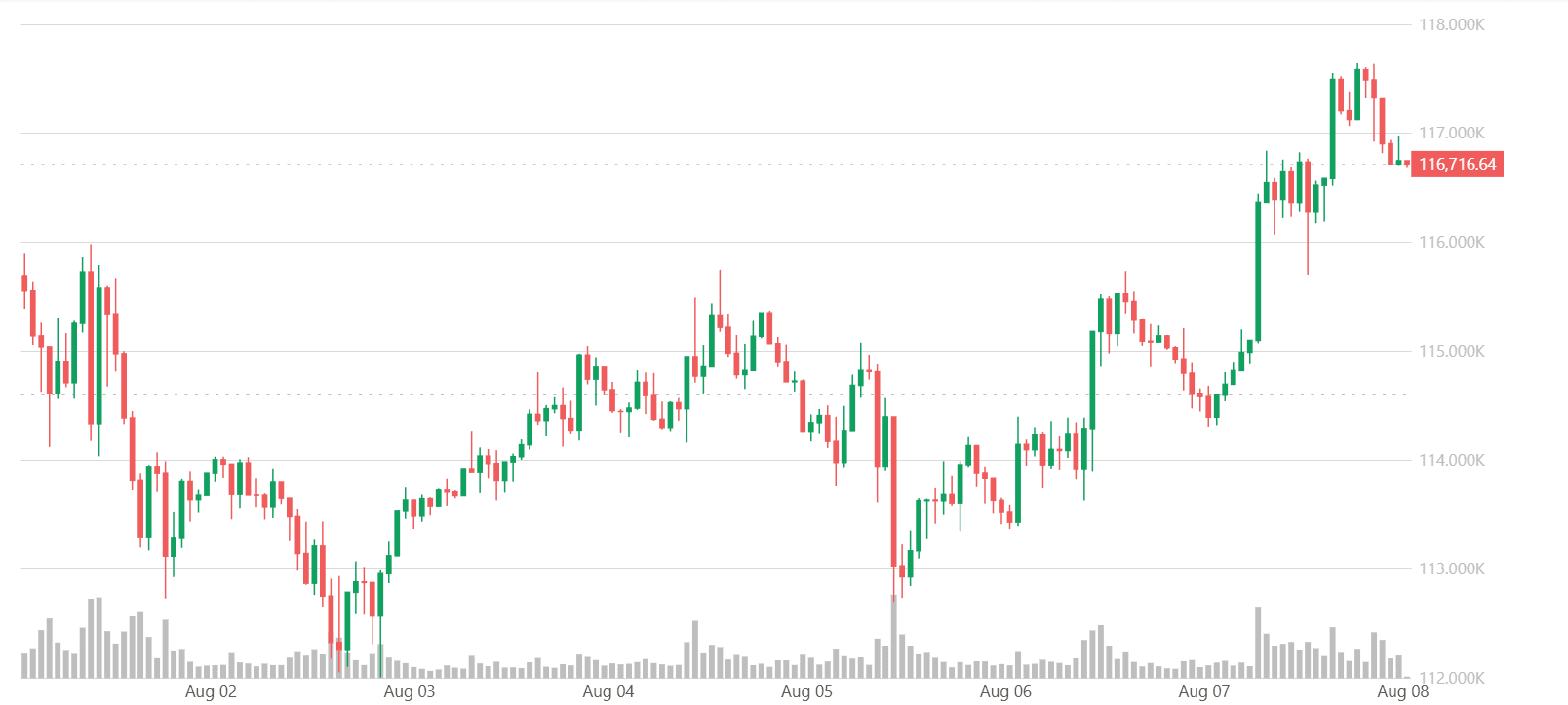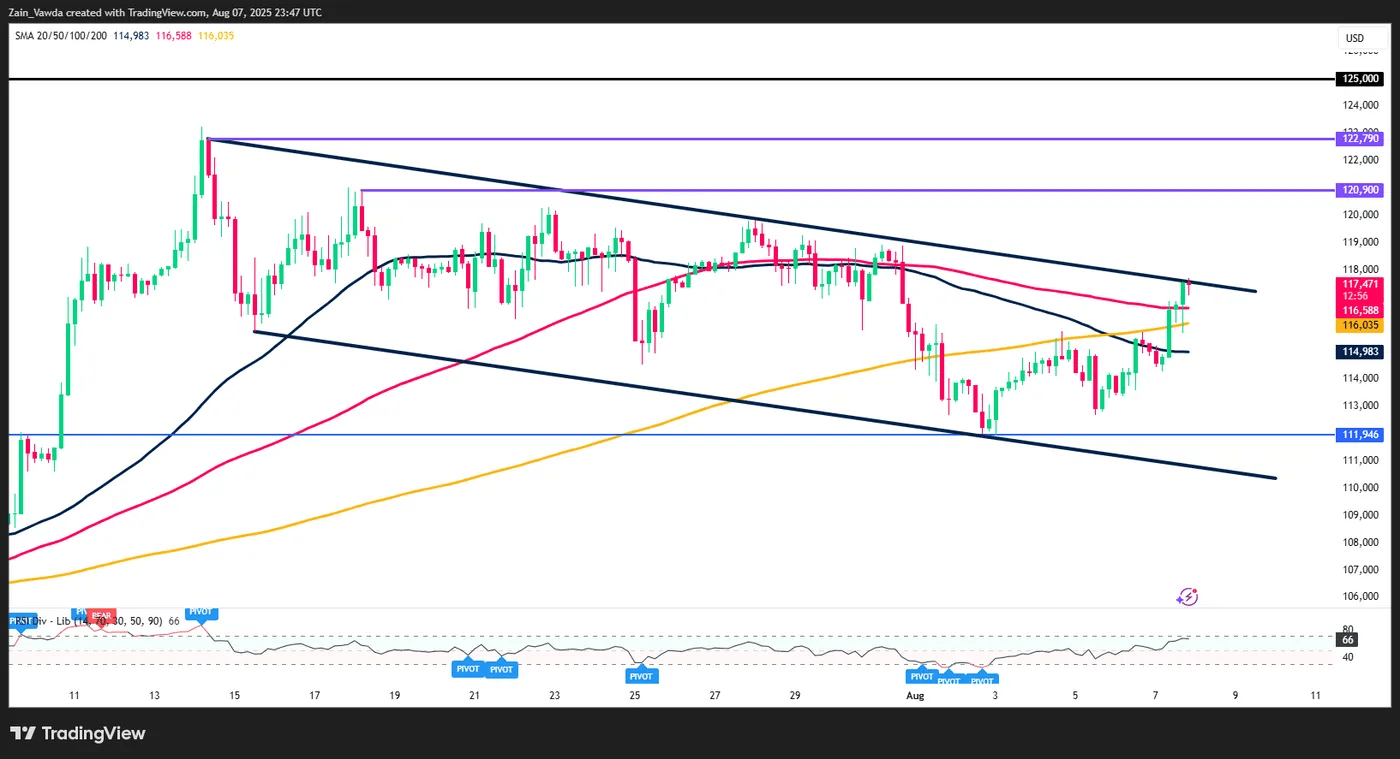On Friday (August 8) during the Asian trading session, Bitcoin rose nearly 2% to above $116,700, shaking off the market tension from the previous week, and returned above $117,500 after President Donald Trump unexpectedly nominated economist Stephen Miran to the Federal Reserve Board.

Bitcoin entered a bullish consolidation phase after reaching an all-time high of $123,000, currently trading at $116,749, temporarily recovering the range it occupied for most of July.
Bitcoin Welcomes Two Major Benefits
The first boost to the crypto market overnight was the news that President Trump plans to sign an executive order allowing the allocation of cryptocurrencies (and other assets) in 401(k) retirement plans — the order has now been signed.
On Thursday, towards the end of the U.S. trading session, the direct catalyst for Bitcoin breaking through $117,000 was the news of Milan's nomination to replace the soon-to-be-departed Andrea Kugler as a member of the Federal Reserve Board.
Trump stated on Truth Social on Thursday that the current chairman of the Council of Economic Advisers and Bitcoin supporter Milan will fill the vacancy left by Adriana Kugler's departure last week, serving until January 31, 2026.
Trump described Milan's economic expertise as 'unparalleled' and stated that he 'performed excellently' in the first Trump administration in 2016. Milan served in the U.S. Treasury during that time and has publicly written in support of Bitcoin multiple times.
Milan, the current chairman of the White House Council of Economic Advisers, is considered to have a close relationship with the president and is likely to at least partially agree with his dovish stance given the current interest rate levels.
Before Milan's nomination, several Federal Reserve officials had indicated in speeches over the past few days that, following last Friday's weak employment data and this Monday's weak ISM services data, they expect the Federal Reserve to cut interest rates at its next meeting in September.
According to the CME FedWatch tool, the probability of a rate cut in September has jumped from 38% a week ago to 95%.
The Federal Reserve's Jackson Hole Economic Symposium will take place in two weeks. In recent years, this meeting has often been an occasion for the Federal Reserve Chair to release important policy signals, so the market's focus will likely be on Jerome Powell's keynote speech.
Does Milan's appointment mean a shift towards more accommodative policy for the Federal Reserve?
Amberdata's derivatives director Greg Magadini stated that traders interpreted Milan's appointment as a signal that the Federal Reserve might shift towards a more accommodative policy, as the Federal Reserve faces ongoing pressure from the Trump administration.
"He is expected to be dovish, which is exactly what Trump wants," Magadini said in an interview with Decrypt, "and the market seems to think so too."
Meanwhile, Magadini warned that if the Federal Reserve shifts in the direction desired by Trump, it could lead to deeper structural risks.
"If the Federal Reserve loses its independence and cannot combat inflation, it's like a mini version of the 1970s," he said, "The end of the Bretton Woods system in the 1970s saw gold prices soar from $35 an ounce in 1970 to $700 in 1980. The current environment — weak Treasury auction demand, rising gold prices, and uncertainty in Federal Reserve policy — is somewhat similar to that time."
The Bretton Woods system was a global monetary system established after World War II that pegged various currencies to the dollar, which was convertible to gold. This system established the International Monetary Fund (IMF) and the World Bank and lasted until 1973 when it transitioned to a floating exchange rate system.
Magadini stated that investors are closely watching the signals from the Federal Reserve as inflation remains stubborn. The latest Personal Consumption Expenditures (PCE) price index is 2.6%, above the Federal Reserve's 2% target and higher than the average of 2.3% over the previous three months.
"Recent U.S. Treasury auctions have shown weak demand, and gold prices have continued to rise," he said, "This tells me that the market sees all of this as inflation risk."
Although Bitcoin is often referred to as 'digital gold,' Magadini pointed out that the total market capitalization of the entire cryptocurrency market is still small compared to traditional assets.
"The market capitalization of Nvidia alone exceeds the total market capitalization of all cryptocurrencies — that’s the sum of over 5,000 cryptocurrencies, while one stock is worth more than all of them combined," he said, "I believe that if market concerns about inflation intensify, cryptocurrencies still have significant room for growth."
Bitcoin Technical Analysis
From a technical perspective, Bitcoin previously completed a retest of the support level at $112,000 and then rebounded. From the four-hour chart, Bitcoin has been in a bullish flag since reaching an all-time high on July 14, 2025.
The current rebound has touched the upper edge of the bullish flag and has re-broken the 50-day, 100-day, and 200-day moving averages. Surprisingly, a 'death cross' pattern appeared on August 5 (Tuesday), but Bitcoin seems unaffected and continues to rise — is this a signal of bullish momentum?
In the current situation, Bitcoin is focusing on a potential bullish flag breakout, which could drive the price up to around $125,000.
In terms of price movements, the price has just reached a higher high, which means it may first pull back to the swing low of $114,555 before continuing to rise and breaking out of the bullish flag pattern.
If the four-hour candlestick closes below $114,555, this pattern will fail, and the price may retest the lower edge of the bullish flag. Support levels may be at $114,555, $112,916, and $112,000.
The current direct resistance level is at $120,000, followed by $120,900 and the historical high of $123,236.
